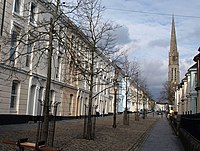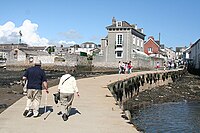Stonehouse, Devon: Difference between revisions
Created page with '{{Infobox town |name=Stonehouse |county=Devon |picture=Royal William Yard.jpg |picture caption=Royal William Victualling Yard |os grid ref=SX463542 |latitude=50.370833 |longitude…' |
|||
| Line 31: | Line 31: | ||
During the reign of Henry VII defences at the mouth of the [[River Tamar|Tamar]] were strengthened by the building of cannon-bearing towers. One of these, the Artillery Tower at the sea end of Durnford Street, has been preserved as a restaurant. | During the reign of Henry VII defences at the mouth of the [[River Tamar|Tamar]] were strengthened by the building of cannon-bearing towers. One of these, the Artillery Tower at the sea end of Durnford Street, has been preserved as a restaurant. | ||
Two of the surviving buildings close to the dock at Millbay are the red brick Portland stone-faced Georgian assembly room that is still called the Long Room, and the exquisite late Georgian or early Victorian Globe Theatre 300 | Two of the surviving buildings close to the dock at Millbay are the red brick Portland stone-faced Georgian assembly room that is still called the Long Room, and the exquisite late Georgian or early Victorian Globe Theatre 300 yards north within the barracks. These were built largely for the pleasures of the officer class and their gentry friends. | ||
On the higher ground towards North Road are two major churches. Firstly St Peter's ([[Church of England]]) with its tall spire in the centre of Georgian | On the higher ground towards North Road are two major churches. Firstly St Peter's ([[Church of England]]) with its tall spire in the centre of Georgian-style Wyndham Square. A few hundred yards east is the mid-Victorian Roman Catholic cathedral of St Mary and St Boniface (1858). Both buildings have recently been restored with reordered interiors to meet modern preferences. | ||
During 1882, Arthur Conan Doyle worked as a newly qualified physician at 1 Durnford Street, East Stonehouse. Plaques bearing passages from his works featuring Sherlock Holmes have since been set into the pavement in Durnford Street.<ref>{{cite web | During 1882, Arthur Conan Doyle worked as a newly qualified physician at 1 Durnford Street, East Stonehouse. Plaques bearing passages from his works featuring Sherlock Holmes have since been set into the pavement in Durnford Street.<ref>{{cite web | ||
Latest revision as of 11:35, 9 August 2015
| Stonehouse | |
| Devon | |
|---|---|
 Royal William Victualling Yard | |
| Location | |
| Grid reference: | SX463542 |
| Location: | 50°22’15"N, 4°9’45"W |
| Data | |
| Post town: | Plymouth |
| Postcode: | PL1 |
| Dialling code: | 01752 |
| Local Government | |
| Council: | Plymouth |
Stonehouse is the middle of the three towns that were amalgamated into modern-day Plymouth, along with Devonport and Plymouth. Stonehouse is centred on the Stonehouse Creek. Once a small village, Stonehouse swiftly became a substantial town when the Royal Navy opened a victualing yard here and developed the lands along the Creek.
Once there were two villages of the name on opposite sides of the Tamar: that on the Stonehouse Creek was also known as "East Stonehouse", while across the river was "West Stonehouse", near Cremyll. The site of West Stonehouse is within the current Mount Edgcumbe Country Park; the village was destroyed by the French in 1350.
Settlement in the area goes back to Roman times and a house made of stone was believed to have stood near to Stonehouse Creek. However other stories relate to land owned in the 13th century by Robert the Bastard. This land subsequently passed to the Durnford family through marriage to the Edgecombe family in the 14th and 15th centuries.
During the 17th, 18th and 19th centuries the areas of Emma Place and Caroline Place were home to many of the West Country's top-ranking admirals, doctors and clergy. Those streets together with Millbay Road are the heart of Plymouth's notorious residual red light district, Union Street, originally built across marshland, was for almost a century the centre of the city's night life with about a hundred pubs, a music hall and many other attractions.
Stonehouse only became significant with the building of the Royal William Victualling Yard between 1826 and 1835. This prompted swift growth in related buildings, houses, docks and businesses, and combined with general Victorian growth of the Three Towns, by the end of the nineteenth century the townscape had grown behind Plymouth Hoe to join Stonehouse up to Plymouth (which had been originally a town gathered by Sutton Harbour).

Much of it was destroyed by bombing in Second World War. After the war what the Luftwaffe had not destroyed, the planners did. The area between Union Street and the dock has been used by small factories, storage, car dealers and repairers. Since 2002 many of those buildings and yards have been cleared and are being replaced by high density residential building.
Notable buildings
Significant buildings include the Royal William Victualling Yard, the Royal Naval Hospital, Stonehouse, and the Royal Marine Barracks. Of these three defence complexes only the Barracks remains in Naval possession, the other two were sold and are now converted to predominantly residential use.
During the reign of Henry VII defences at the mouth of the Tamar were strengthened by the building of cannon-bearing towers. One of these, the Artillery Tower at the sea end of Durnford Street, has been preserved as a restaurant.
Two of the surviving buildings close to the dock at Millbay are the red brick Portland stone-faced Georgian assembly room that is still called the Long Room, and the exquisite late Georgian or early Victorian Globe Theatre 300 yards north within the barracks. These were built largely for the pleasures of the officer class and their gentry friends.
On the higher ground towards North Road are two major churches. Firstly St Peter's (Church of England) with its tall spire in the centre of Georgian-style Wyndham Square. A few hundred yards east is the mid-Victorian Roman Catholic cathedral of St Mary and St Boniface (1858). Both buildings have recently been restored with reordered interiors to meet modern preferences.
During 1882, Arthur Conan Doyle worked as a newly qualified physician at 1 Durnford Street, East Stonehouse. Plaques bearing passages from his works featuring Sherlock Holmes have since been set into the pavement in Durnford Street.[1]
Regeneration

Between 1993 and 1998 the part of Stonehouse to the west of Durnford Street (including the Royal William Victualling Yard) was designated as one of the three areas of the city under control of Plymouth Development Corporation. Gradually affluent residents are moving back into the district which has been comparatively poor since the Great War. Durnford Street is being regentrified. The walled enclosures of the Royal William Yard and the old Naval Hospital (known as the Millfields) are gated communities with security guards. The government's pressure to develop mixed quality high density dwellings on brownfield sites in inner cities has led to new residential blocks having been built throughout the area. Planned post war as a primarily commercial/industrial area it is now perceptibly changing its character. What was a dozen or so years ago viewed as one of the poorest and most deprived areas in northwest Europe is fast losing that image.
On Stonehouse Creek, a branch of the Tamar, off the estuary known as the Hamoaze are the modern shipbuilding sheds occupied by the luxury motor-yacht firm Princess Yachts who employ hundreds of local tradesmen to construct and fit out expensive vessels. The creek now ends at Stonehouse Bridge (for many years a toll bridge) and to the north east the wide river bed which led up past Millbridge to Pennycomequick and beyond to the bottom of Ford Park Cemetery, has been reclaimed and infilled to provide the playing fields of Victoria Park, rugby pitches for Devonport High School for Boys, and nearest the bridge a large hardstanding used several days a week for Plymouth's biggest car boot sales. To the north is the main campus of what was Plymouth College of Further Education, now called City College.
Stonehouse is the site of Plymouth's international ferry port at Millbay Docks with at least daily sailings to Roscoff in Brittany and frequent ferries to Santander in northern Spain. Until the 1950s, transatlantic liners would disembark passengers who wished to catch a fast train to London rather than spend another day on board going up the Channel.
There is a regular passenger ferry from the tidal landing Admiral's Hard to Cremyll across the Tamar, which is used for visitors to the Mount Edgcumbe Country Park, and commuters to Plymouth.
Sport
- Football: Stonehouse Glass FC
- Rugby:
- Devonport High School Old Boys RFC
- The Stonehouse Sharks Youth Rugby Club
- both play out of The Stonehouse Creek Community centre, built in 2003
References
- ↑ "Walk 72 - Plymouth Waterfront Walk". Devon County Council. http://www.devon.gov.uk/index/environmentplanning/public_rights_of_way/where_to_walk_and_ride/daywalks/walk72.htm. Retrieved 2010-05-04.